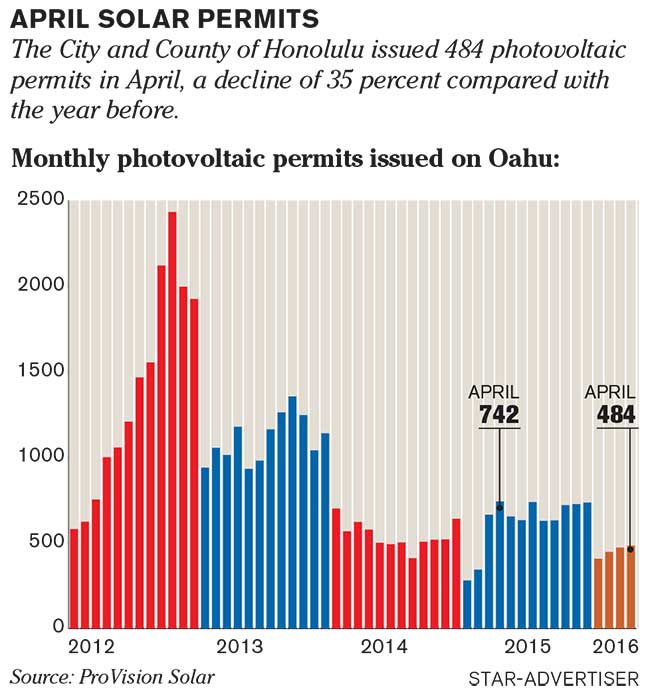Hawaii’s solar industry continues to struggle after the state ended a popular solar incentive program in October.
The Hawaii Solar Energy Association, a solar advocacy group, said Monday a survey of 11 member companies showed 73 percent have decreased staff since the incentive program ended. On average, the companies cut their staff by 35 percent, the HSEA said. The report did not give the actual number of workers laid off.
“It’s taking longer than expected to recover from the loss of net energy metering (the incentive program), and consumers and workers are paying the price,” said HSEA President Rick Reed in the monthly report.
The slowdown was sparked when the Public Utilities Commission ended net energy metering, a program that credits customers the full retail rate for the excess energy their solar systems produce.
The agency replaced NEM with two programs: customer grid-supply and customer self-supply. The grid-supply program credit is roughly 8 cents lower per kilowatt-hour than the full retail rate offered with NEM, which was 22.6 cents a kilowatt-hour in April. With self-supply, customers are prohibited from sending excess energy from their solar systems to the grid. They can buy a battery to store the power from their solar systems and can draw from the grid when their battery runs out.
Companies said that layoffs would have been more severe if not for a backlog of NEM application approvals. There were 12,746 NEM applications approved for installation or awaiting execution as of April 26, according to data from Hawaiian Electric Co.
A separate report showed that building permits for rooftop solar systems declined in April compared with the same month last year.
The City and County of Honolulu issued 484 photovoltaic permits last month, a decline of 35 percent compared with April 2015, according to data from Marco Mangelsdorf, who tracks rooftop solar permits and is president of Hilo-based ProVision Solar. Installed systems were down 26 percent since April 2015, according to building permit records.
The HSEA said the industry did see an increase in approved grid-supply applications. Grid-supply approvals grew by 415 applications last month to a total of 1,022 approved applications as of April 26. That was a 68 percent increase from March, HSEA said.
The HSEA said the benefits of the grid-supply program will be short-lived “if the statewide interim grid-supply cap of 35 megawatts is not raised.”
When creating the new program, the PUC put a cap of 35 megawatts on the total amount of grid-supply solar in all three of HECO’s territories, including Maui Electric Co. and Hawaii Electric Light on Big Island. The cap breaks down to 25 megawatts on Oahu, or roughly 4,500 systems.
PUC Chairman Randy Iwase said that the cap was necessary to make more room for other renewables to be connected to the grid. Hawaiian Electric Co. has reported having problems with high levels of rooftop solar connected to the grid.
The HSEA said the industry is nearing the halfway point to reaching the cap. The number of grid-supply applications already submitted equals 15 megawatts of the 35-megawatt cap, the association said.
The coalition also said self-supply, or battery plus solar, option suffered a setback with the failure of two bills to win passage by the Legislature this session. That “leaves the self-supply program in a precarious position.” One bill, SB 2738, would have given homeowners a rebate for installing a battery system to store solar power. The other bill, HB 2291, would have given a 25 percent tax credit for solar-powered batteries.
“The success of self-supply heavily relies on energy storage: however, as it stands, this technology remains expensive, despite plummeting costs in recent years,” the HSEA said.



